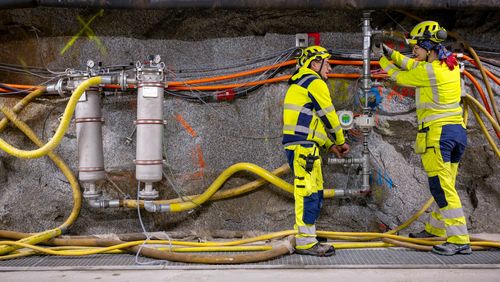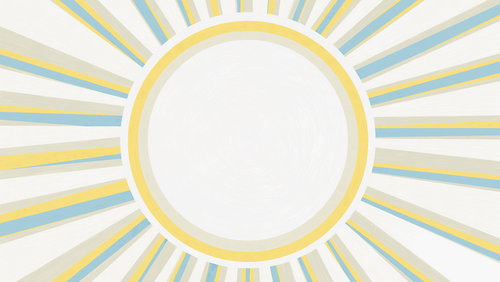
High hopes for geothermal energy
2019 was a momentous year for deep geothermal energy. Thanks to funding from the Werner Siemens Foundation, researchers from ETH Zurich were able to set up a unique underground laboratory in a former ventilation tunnel deep within the Saint Gotthard Massif of the central Swiss Alps. In the new Bedretto Underground Laboratory for Geoenergies, the team want to see whether—and how—they can tap into the heat of the earth without triggering dangerous earthquakes.
Until recently, all was quiet in Val Bedretto. Sun-hungry tourists from the north would motor past quickly, not giving the valley so much as a glance when passing through the Alps on their way south to Italy and the sea. But in 2019, Val Bedretto achieved international fame—at least among experts in geothermal energy, who, after exiting the Gotthard tunnel, began taking a sharp turn westwards and driving up the valley. Their destination is a former ventilation arm in the Furka Tunnel—part of the Matterhorn-Gotthard railwayline—that quite literally has the goods: it harbours a state-of-the-art underground lab for deep geothermal energy research—a world’s first that was made possible thanks to funding from the Werner Siemens Foundation. In the nearauthentic conditions in the Bedretto Underground Lab, leading research groups from throughout Europe want to observe how granite reacts to deep drilling and so-called stimulation treatments in which high-pressure water injections generate numerous fine cracks (called joints) in the granite (more information in the interview).

Underworld paradise
It was Domenico Giardini who had the idea to convert the former ventilation arm into an underground lab. Giardini, professor of seismology and geodynamics at ETH Zurich and a respected expert in deep geothermal energy, had previously conducted research in the Grimsel rock laboratory, but the Bedretto Underground Lab is in a league of its own. The facility is located a good 2 200 metres in the interior of the mountain, with Piz Rotondo, the highest mountain in the Saint Gotthard Massif, towering some 1 000 metres over the tunnel—an underworld heaven for deep geothermal energy researchers. The purpose of the Bedretto Underground Lab is, however, not to conduct research for the sake of research: rather, the tests are designed to provide clear answers to concrete questions regarding the feasibility of deep geothermal energy in Switzerland and other regions. Specifically, the researchers want to find out whether the risk of triggering earthquakes through drilling and stimulation is too high.
Switzerland’s energy strategy
Switzerland is one of several European countries that plan to phase out nuclear energy and replace fossil fuels (natural gas and oil) with renewable energies. In 2007, the Swiss federal government set out an initial set of guidelines for achieving the national energy transition; the goal of reducing CO2 emissions was then formalised in the federal CO2 act in 2011. In 2019, the Federal Council and the chambers of parliament initiated deliberations on a comprehensive revision of the CO2 act with the aim of further tightening the targeted levels for CO2 emissions. With reference to the legal provisions for increasing the energy supply from CO2-neutral technologies and renewable energy sources, a team of energy experts—including Domenico Giardini—developed the idea to tap into a single renewable energy source that would, in future, cover most of the energy demand in Switzerland. This source could then be supplemented by alternative energy technologies like water, solar and wind, which are susceptible to seasonal fluctuations. A key requirement of the chosen renewable energy source is its capacity to provide electricity throughout the year, especially in the cold winter months—and deep geothermal energy would be up to the task. After all, below the earth’s surface, the temperature is stable all year round, roughly 60 degrees Celsius at a depth of two kilometres. If we could tap into this heat, we could use it to generate electricity, even in winter.

Which renewable energy source?
It would be possible to argue that water, and thus hydropower, is plentiful in Switzerland and has proved reliable for decades—and that it would therefore be a better choice than deep geothermal energy. But Domenico Giardini counters: “Hydropower is currently the most important domestic energy source and it has the largest storage capacities. But it would require a massive amount of additional infrastructure to further expand its capabilities. Moreover, hydropower relies on a sufficient supply of water, which, however, is affected by climate change and water consumption, not to mention various other economic and socio-political factors.” Indeed, the construction of dams often faces stiff opposition, and the only current project is a new dam at the Susten Pass, where the Trift Glacier melted and formed a new lake. How many new dams would have to be built to ensure that hydropower could deliver the basic energy supply is illustrated by the following calculation: every year, nuclear power stations in Switzerland produce some 25 million megawatt-hours of electricity, which corresponds to roughly 40 percent of Switzerland’s energy needs. If all nuclear power plants were replaced by hydropower plants, at least 170 new dams would have to be built, all of which would need to have the dimensions of the projected Trift dam. Highly unrealistic, says Giardini, adding that in its Energy Strategy 2050, “the federal government is reckoning at the most with a 10 percent increase in electricity generated by hydropower plants”.
Solar power is currently also not able to deliver the basic energy supply, as it is only generated during the day, mainly in summer, and when the skies are clear. Seen on an annual basis, that would be only 15 percent of the time. Finally, wind power is an even less likely candidate due to the low acceptance of wind farms in the population; moreover, only a few regions (the Jura region, for example) are windy enough.
The right mix
“The sustainable energy sources we currently use—water, solar, wind and hot thermal water—can’t meet our energy needs in winter,” is how Giardini sums up the problem. “But that’s not to say we shouldn’t use them. What we need is a good mix to guarantee a year-round energy supply.” And this is where deep geothermal energy has a clear advantage: having no seasonal or weather-related limitations, it would be well-suited to deliver the basic energy supply—if the associated risks can be borne. In any event, the Swiss federal energy strategy forecasts that deep geothermal energy will furnish roughly seven percent of Switzerland’s electricity by 2050.
In order to answer the open questions on Switzerland’s energy transition, the Federal Office of Energy resolved to increase funding for energy research in general, and for deep geothermal energy in particular. The government created eight competence centres for energy research and named Domenico Giardini head of the Swiss Competence Center for Energy Research – Supply of Electricity. His suggestion to convert the former ventilation shaft in Val Bedretto into . an underground lab for researching deep geothermal energy met with broad acceptance—but who would cover the rather prohibitive costs? Giardini says, “The Werner Siemens Foundation was the first organisation to believe in the Bedretto Underground Lab and to offer substantial funding. This confidence inspired other interested organisations and large financial backers like ETH Zurich and the Federal Office of Energy to commit to the project.” Since October of 2019, the European Union has also been on board. The EU has a particular interest in the Bedretto Lab, as researchers from various countries collaborate and consolidate their knowledge. These synergies can also be applied in different contexts, for example, to better predict earthquakes in Italy and other earthquake-prone European countries. For this reason, the European Research Council (ERC) has awarded Domenico Giardini a six-year grant in the amount of 14 million euros.

Massive undertaking
In the meantime, the Bedretto Underground Lab has become a huge undertaking in which all relevant federal offices, private industrial companies and key research groups from Switzerland and abroad work together to determine what role deep geothermal energy can play in the national energy supply. The industry partners were involved in planning from the outset, as they supplied the technology and equipment, which they also plan to test in the lab. Researchers in the field of deep geothermal energy from throughout Europe were also invited to join the project; of these, the Finnish industrial and research partners are of particular importance, as their successful procedures will be tested in the Bedretto Underground Lab.
Leading researcher Martin O. Saar
One of the leading researchers in the underground lab is Martin O. Saar, professor of geothermal energy and geofluids at ETH Zurich and Werner Siemens Foundation Endowed Chair. Saar and his research group are analysing the behaviour of granite before and after water is injected into the rock (stress measurements). With the help of markers (called tracers), they can also observe where the water flows and how hot the rock is at a given location. Nevertheless, Domenico Giardini stresses that we need a deeper understanding of how drilling and stimulation treatments actually impact the rock: “Later, when we’re drilling four to five kilometres underground to build a geothermal energy power station, we’ll have reached a level where there’s enormous pressure, meaning we’ll be disturbing the natural tectonic motions in the interior of the mountain.” An additional problem is that the researchers cannot predict the long-term effects of the large quantities of water that will be injected into the rock and transported back to the surface.

Before an experiment begins, the hydraulic conditions (pressure and flow rates) in the borehole are measured.
Safety is paramount
The researchers already have a wealth of knowledge, but the devil, as always, is in the detail. And it is precisely these details that the tests in the Bedretto Underground Lab must answer if deep geothermal energy is to form part of the Swiss Energy Strategy 2050. “If the tests in the Bedretto Underground Lab go wrong, the entire future of deep geothermal energy in Switzerland will be called into question,” says Giardini. “We have to demonstrate with absolute certainty that the risk of triggering dangerous earthquakes through drilling can be contained—only then will we receive permission to build deep geothermal energy power stations. The government authorities, the population, industrial partners and we researchers must have full confidence in the results.”
How does Domenico Giardini rate the probability of establishing deep geothermal energy in Switzerland? Surprisingly high. “We still need time before we’re able to use sustainable energy sources in all areas of life. But I think that by 2050, every Swiss canton could and should be operating a geothermal energy power station.”
Text: Brigitt Blöchlinger
Photos: Felix Wey





